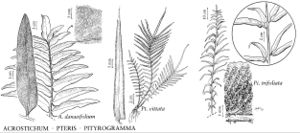Pteris
Sp. Pl. 2: 1073. 1753; Gen. Pl. ed 5, 484. 1754.
| Taxon | Illustrator ⠉ | |
|---|---|---|
 | Acrostichum danaeifolium Pityrogramma trifoliata Pteris vittata | John Myers John Myers John Myers |
Plants terrestrial or on rock. Stems erect or creeping, branched; scales pale-brown to black, concolored, elongate, margins entire. Leaves monomorphic, clustered or closely spaced, 1–20 dm. Petiole straw-colored, green, brownish red to purple black, longitudinally ridged, 2–3-grooved adaxially, scaly at base, glabrous or scaly distally, with 1 (less often 2 or more) vascular-bundle. Blade oblong to lanceolate to deltate, 1–4-pinnate, herbaceous to leathery, abaxially and adaxially glabrous or sometimes pubescent or scaly, adaxially dull, not striate; rachis straight. Ultimate segments of blade sessile to short-stalked, linear to oblong-lanceolate, 1.5–8 mm wide; base truncate or narrowed to stalk, stalk when present green, not lustrous; margins plane or reflexed to form false indusia. Veins in leaves conspicuous, free (except in sori) and forking well above base of segment, or highly anastomosing. False indusia pale, scarious, covering sori. Sporangia intramarginal, sori usually continuous except at pinna or segment apex and sinuses, paraphyses present. Spores brown, trilete, tetrahedral, rugate and/or tuberculate, usually with prominent equatorial flange. x = 29.
Distribution
Worldwide, warm and tropical regions
Discussion
Species ca. 300 (5 species and 1 hybrid in the flora).
Selected References
Key
| 1 | Veins in leaves anastomosing except sometimes near margins of ultimate segments. | Pteris tripartita |
| 1 | Veins in leaves entirely free. | > 2 |
| 2 | Leaves not strictly 1-pinnate, at least proximal pinnae pinnatifid-lobed or variously forked or divided. | > 3 |
| 2 | Leaves strictly 1-pinnate, pinnae not lobed or divided. | > 4 |
| 3 | Pinnae of mature leaves decurrent to relatively broad-winged rachis in at least distal 1/2 of leaf. | Pteris multifida |
| 3 | Pinnae of mature leaves not decurrent to relatively broad-winged rachis or only terminal pinna decurrent on rachis. | Pteris cretica |
| 4 | Petioles and often also rachises densely scaly, scales light to reddish, often grading into hairs on abaxial costae; pinnae appearing not articulate to rachis, apices long-attenuate or sharply acute; sori narrow, with most of abaxial blade surface exposed. | Pteris vittata |
| 4 | Petioles often sparsely scaly or scaly only proximally, scales dark brown to nearly black, scales absent or few on rachises, abaxial costae with or without hairs; pinnae appearing articulate to rachis, apices acute; sori broad, little or no abaxial blade tissue exposed. | Pteris bahamensis |
"dm" is not declared as a valid unit of measurement for this property.